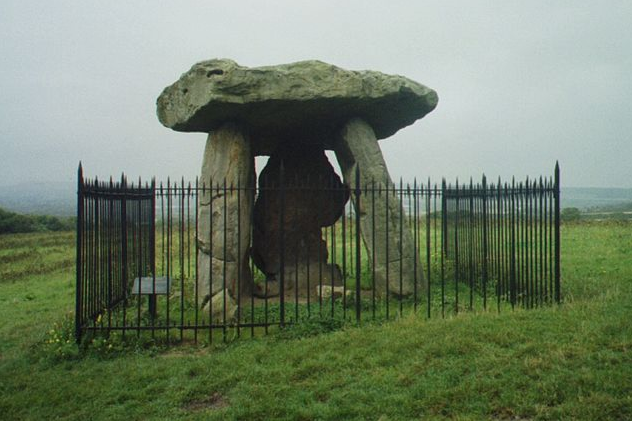 Music
Music  Music
Music  History
History 10 Less Than Jolly Events That Occurred on December 25
 Weird Stuff
Weird Stuff 10 Funny Ways That Researchers Overthink Christmas
 Politics
Politics 10 Political Scandals That Sent Crowds Into the Streets
 Weird Stuff
Weird Stuff Ten Bizarre Facts About The Doge Meme
 Our World
Our World 10 Ways Your Christmas Tree Is More Lit Than You Think
 Movies and TV
Movies and TV The 10 Coolest Stars to Set Sail on The Love Boat
 History
History 10 Things You Didn’t Know About the American National Anthem
 Technology
Technology Top 10 Everyday Tech Buzzwords That Hide a Darker Past
 Humans
Humans 10 Everyday Human Behaviors That Are Actually Survival Instincts
 Music
Music 10 Surprising Origin Stories of Your Favorite Holiday Songs
 History
History 10 Less Than Jolly Events That Occurred on December 25
 Weird Stuff
Weird Stuff 10 Funny Ways That Researchers Overthink Christmas
Who's Behind Listverse?

Jamie Frater
Head Editor
Jamie founded Listverse due to an insatiable desire to share fascinating, obscure, and bizarre facts. He has been a guest speaker on numerous national radio and television stations and is a five time published author.
More About Us Politics
Politics 10 Political Scandals That Sent Crowds Into the Streets
 Weird Stuff
Weird Stuff Ten Bizarre Facts About The Doge Meme
 Our World
Our World 10 Ways Your Christmas Tree Is More Lit Than You Think
 Movies and TV
Movies and TV The 10 Coolest Stars to Set Sail on The Love Boat
 History
History 10 Things You Didn’t Know About the American National Anthem
 Technology
Technology Top 10 Everyday Tech Buzzwords That Hide a Darker Past
 Humans
Humans 10 Everyday Human Behaviors That Are Actually Survival Instincts
10 Legends Of Ancient Megaliths And Stones From The British Isles
The standing stones and portal tombs of Britain and Ireland are among some of the most enigmatic reminders of the fact that people walked the isles thousands of years ago. They were astronomical calendars, burial places, and sites of long forgotten ancient rituals. More recently, they’ve given birth to myths and legends that attempt to explain just how they came to be—and what happens to those who disrespect them.
10 Nine Stane Rig
Scotland
The Nine Stane Rig (aka the Nine Stanes Stone Circle or the Ninestane Rig) is nestled among trees in the borderlands between Scotland and England. The prehistoric stones are thought to have been erected as a calendar for local farmers, telling them when to plant their crops by measuring the movement of the Moon against the circle. Later, it became a cairn, and that’s where the creepy part comes in.
The circle is only a few miles away from the now-abandoned Hermitage Castle. According to local legend, the castle was once home to William de Soulis (or de Soules), the second inhabitant of the castle. The 13th-century lord was popularly known as “Bad Lord Soulis” and occasionally as “Terrible William.” With those nicknames, it’s no surprise that the stories told about him include his penchant for practicing black magic. It was a pastime that necessitated the torture and murder of local children, whom he kidnapped and killed in the dungeons of the castle.
At first, the locals could do little to stop him, as he was under the protection of a spirit familiar named Robin Redcap. When de Soulis sold his soul to the Devil, he gained the protection of Redcap and was promised that the only thing that could ever kill him was a rope made of sand. He made no secret of that fact, so the townsfolk recruited the help of a wizard of their own, Thomas of Ercildourne.
While the wizard created a sand-filled lead belt, the townsfolk revolted against their lord. They stormed the castle and dragged him to the nearby Nine Stane Rig. A cauldron was waiting for him, and they bound him with the magic belt, rolled him up in a sheet of lead, and melted him down.
Both Hermitage Castle and the Nine Stanes Stone Circle are supposedly still haunted by the spirit of Bad Lord Soulis, and people have claimed to still hear the screams of the children he murdered for his black rites and rituals.
9 Men-an-Tol
Cornwall, England
Men-an-Tol, a 3,500-year-old Bronze Age megalith, is one of the strangest giant stones in Britain. It features a holed stone set between three other upright pillar stones. There is only one other such holed stone in the country. No one is sure what the purpose of the holed stone originally was, but it’s given rise to a few legends.
Men-an-Tol is also known as the Crick Stone, and it’s said that children who are passed back and forth through the hole will be cured of chronic illnesses. It was especially associated with curing rickets. Women who crawled through the stone under the light of the full moon would become fertile and soon become pregnant. It’s also said that anyone who puts two brass pins on the top of the holed rock and asks yes-or-no questions will have those questions answered by the movement of the pins, although it’s not clear what means “yes” and what means “no.”
Most of the phenomena credited to Men-an-Tol are said to be the work of a guardian fairy that lives at the stones. While many fairies were evil tricksters, the Men-an-Tol fairy is a good one, thought to be able to both cure illness and undo the work of more diabolical fairies.
Belief in changelings was a very real thing in Cornwall for a surprising amount of time. People believed that fairies would steal a newborn human child and replace it with one of their own offspring. As the changeling grew up, it would become more disturbed and less like the human it appeared to be. Sometime between 1830 and 1860, a child suspected of being a changeling was passed through the hole. It was thought that the good fairy would be able to return the human child to the family that it had been stolen from.
Part of the problem in determining what the stone was for is the fact that we have no idea what it originally looked like. It’s believed that the stones still standing aren’t in their original position and that they were once a part of a larger stone circle, the remnants of which are still buried beneath the ground.
8 Long Meg And Her Daughters
Cumbria, England
Also dated to be around 3,500 years old, the stone circle known as Long Meg and her Daughters is the second-largest in England. The monument is comprised of 59 stones, though it’s believed that there were originally as many as 77 as well as two cairns, which have disappeared.
The tallest stone is known as Long Meg, which stands 3.8 meters (12.5 ft) tall and is positioned outside the circle itself. It’s said that “Meg” refers to a local witch known as Meg of Meldon, who was turned to stone for disrespecting the sanctity of the Sabbath and dancing on the sacred day. The smaller stones are her daughters (or her coven), who joined her in her sacrilegious dance.
One version of the story states that legendary Scottish wizard Michael Scott turned the coven to stone. Scott was a real person. He was a monk and scholar whose work in astronomy, the occult, and demonology, along with his ability to read and speak languages like Arabic and Greek, turned him into someone who walked the line between magician, monk, and witch himself.
Like a number of stone circles across Britain, it’s claimed to be impossible to accurately count all the stones. This is good, because if anyone ever succeeded, it would break Scott’s spell, and the witches would return to the land of the living. Some stories suggest that if a piece of a stone is chipped away, it’ll bleed as though it were alive.
Legend also says that the stones are quite capable of protecting themselves against anyone who would want to move or destroy them. Sometime in the 1700s, a local man named Colonel Lacy tried to blow up the stones in the circle, likely thinking that he was going to find the buried treasure sometimes said to be beneath them. A terrible storm tore through the area, thwarting his plans and making it clear that the circle had powerful protectors.
7 Knocknarea
County Sligo, Ireland
The ancient cairn that dominates Sligo’s limestone Knocknarea hill is the largest of Ireland’s unopened neolithic cairns, thought to contain the remains of an ancient burial site. There are several stone structures on the top of the hill, and the biggest is Meascan Meadhbha.
The so-called Maeve’s Cairn is reputed to be the final resting place of Connaught’s Queen Maeve, the warrior queen who was given Connemara by her father. When she was comparing her wealth to that of one of her husbands, the discovery of the only thing he had that she lacked, a bull of equal quality, led to the epic story of the Cattle Raid of Cooley, one of many stories told about battles between Maeve and her neighbors.
Tradition states that when Maeve was buried in the cairn on Knocknarea, she was buried standing and fully armored with her spear in her hand, facing the direction of her enemies from Ulster. Buried in the other cairns are some of her most important warriors and others who had taken a stand for Connemara. The warrior Eoghan Bell was buried in Rath O’Fiachrach (which was likely Knocknarea), and he, too, was buried standing, facing Ulster with his spear in his hand.
After Bell’s death, the men of Connaught continuously seemed to have the upper hand. When the Ulstermen found out that their enemies still had the protection of their lord, it’s said they raided Bell’s burial mound and dug him up. They reburied him elsewhere, upside down. From then on, the battles were more evenly matched.
6 Mitchell’s Fold
Shropshire, England
There were originally around 30 stones at Mitchell’s Fold, standing on the border between England and Wales just outside Chirbury. There are only 15 left today, and the circle has been dated to sometime between 2000 and 1400 BC. Most of the stones are relatively small, at less than a few feet tall. However, they’re connected with a massive legend; it’s said that one of the stones is the one that King Arthur pulled his sword from.
As with many standing stones, there’s a legend of how Mitchell’s Fold came to be. A long time ago, a drought seized the land. Crops withered, livestock died, and people started to die, too. Fortunately, the area was also home to a kindly witch who took pity on her neighbors and gave them a lifesaving gift—that came with one condition. The gift was a cow whose milk would never run dry as long as each person only took a single bucket to fill from her at a time. For a while, the townspeople did exactly that. Where there’s good, there’s evil, though, and an evil witch milked the cow not into a pail, but into a sieve.
When a flash of lightning lit up the night sky and the cow saw all her wasted milk spilling onto the ground, she kicked the witch and fled. When the townspeople went to the hill the next morning, they saw that something had turned the bad witch to stone as an eternal punishment.
While the stones themselves are incredibly ancient, it’s unknown how long the legend dates back. At the very least, it’s from the late 19th century, as the story was carved into a pillar at a nearby church at that time.
5 Avebury And The West Kennet Long Barrow
England
The landscape of Avebury is dotted with prehistoric monuments, standing stones, and long barrows. As one of Britain’s most famous megalithic sites, it’s second perhaps only to Stonehenge in popularity. That doesn’t mean we know very much about it, however. It’s certainly ripe for legends, which have sprung up around the individual standing stones across the area.
The Devil’s Chair is one of the largest of the standing stones, and it sits where the Avebury circle and West Kennet join. It has surprisingly little to do with the actual Devil. Instead, it’s thought to grant the wishes of any woman who sits on it during the Beltane (May Day Eve) celebrations.
Not far away is the Diamond Stone. Legends say it has been known to cross the road at midnight, a feat that may or may not have something to so with the mysterious figures that some claim to have seen walking among the stones. People driving past have reported activity that they’ve mistaken for a full-blown fair or carnival.
The nearby West Kennet Long Barrow was excavated in the 1950s and found to be the final resting place of at least 50 people. An earlier excavation in 1859 probably inadvertently destroyed more evidence, so we’re not sure what kinds of ceremonies and rituals might have taken place there. Old legends tell of a spectral figure that visits the site every Midsummer’s Day at sunrise, accompanied by a white hound with red ears, possibly the folktales and remnants of a much older ceremony.
For those who believe in the idea of ley lines, more recent folklore about Avebury and the West Kennet Long Barrow suggests that the whole site sits at the intersection of two major ley lines—the lines of St. Michael and St. Mary. Believers toss around ideas such as the convergence of energy and power, and the site, especially the long barrow, has become a major center for modern pagans.
4 Stanton Drew
Somerset, England
There are three individual stone circles in Stanton Drew: The largest of the circles, known as the Great Circle, has 26 stones that have survived since the Bronze Age. The Cove has 11 stones remaining, and the Northeast Circle still has eight stones. The first records of them only date from 1664, and it wasn’t until 1776 that they were completely mapped.
The most widely told tale about the stones is a Christian story applied to a distinctly ancient site. One Saturday, ages ago, a wedding was being held in the Somerset countryside. After the wedding, of course, came the feast. As the day turned into night and midnight approached, everyone was having so much fun that they forgot about the approaching Sabbath. As the clock struck midnight, the wedding’s fiddler stopped playing and refused to continue—even when the bride demanded that the party keep going, even if she had to go to Hell to find a fiddler.
Once she started throwing words like that around, the Devil himself showed up. Bearing a fiddle of his own, he played and played, faster and faster, until dawn. When the Sun rose, everyone had been turned to stone. The Great Circle and the Northeast Circle are made up of the wedding guests, while the standing stones of the Cove are the parson and the ill-fated bride and groom.
Later, the fiddler who refused to play past midnight was found among the stones, and the legend is said to come from his recounting of the tale. The Devil left with the souls of the entire wedding party (except the fiddler’s), and he also left with a promise that day: He’d be back to play for them again.
3 Callanish Stone Circle
Isle Of Lewis, Scotland
According to legend, the standing stones of Callanish (or Callanais) were buried beneath the earth until years ago, when a local farmer was walking the island while he looked for rocks to build a wall with. He came across what he thought was a single small stone, but when he started to dig, he found that the rock kept going. He dug deeper and deeper and eventually uncovered the ancient stone circle.
Regardless of whether or not they were ever uncovered by what had to be the most determined farmer in Scotland, excavations of the stones have allowed them to be dated to somewhere between 2900 and 2600 BC, and they were a center of activity for somewhere between 1,000 and 1,500 years. At that point, it seems that a central circle of stones was destroyed, and the rest of the area was covered in peat in what might have been some sort of ritual cleansing. In 1857, the peat was cut to reveal the stones once more, perhaps leading to their origin story.
The stones have an odd alignment. It’s been found that every 18.6 years, the Moon is low enough in the sky that it appears to float across the tops of the stones.
The Callanish stones’ Gaelic name is Fir Bhreig, which translates to “The False Men.” Like many of the neolithic stone monuments, this one also has a bit of Christian mythology and folklore attached to its supposed creation. Legend says that the stones were once men, occasionally referred to as giants, who were visited by Saint Kieran. The missionary tried to convert them to Christianity, but when they kept refusing, they were turned into the stones that still stand on the isle.
2 Kit’s Coty
Maidstone, England

All that remains of Kit’s Cody, a Neolithic chambered tomb, are three upright stones and the capstone. Its odd name comes from the legend surrounding the tomb. “Cody” simply means “house,” and “Kit” is likely a reference to a man named Catigern.
The story of Catigern and his brother, Vortimer, shows up in various historical writings several times. In 455, the brothers took up arms to drive the Saxons off their lands. The outcome of the battles is unclear, but Catigern was killed, and one of his other brothers became king after the death of their father.
The ill-fated Catigern is supposedly buried beneath Kit’s Cody, but his spirit is a restless one. The area is reported to be the site of regular spectral reenactments of that fateful battle, where armies fight again and again for control over the nearby ford across the river.
Legend says that if you visit Kit’s Cody on a night with no moon, put any object on the top of the capstone, and then walk three times around the stone counter-clockwise, the object will disappear. There’s also a legend stating that it’s impossible to count the number of smaller stones that litter the ground only a short distance from Kit’s Cody. The so-called Countless Stones are thought to be all that remains of another tomb, and if two or more people try to count the stones, everyone will come up with a different number.
Local lore tells of an enterprising baker who decided to find out once and for all how many stones there were by putting a loaf of bread on top of each one. When he finished and went to count the loaves that were still in his basket, he died before he could speak the number of the stones. Another ending to that story says that when he counted the leftover loaves, he found more in his basket than he had brought in the first place.
1 The Rollright Stones
Oxfordshire, England
The legend of the Rollright Stones is an old one, first written down in 1586.
There was an ancient king who decided that he wanted to claim all of England for himself and unite the country under his rule, so he prepared his troops for battle and started marching. When he reached Oxfordshire, he found a witch standing in his way. (According to some versions, the witch was the infamous seer and prophet Mother Shipton.) The witch told him, “Seven long strides shalt thou take, And if Long Compton thou canst see, King of England thou shalt be.”
The king, thrilled by the idea, took his seven strides. As his foot hit the ground on the seventh step, the Earth rose up and blocked his view, condemning him and his men. The king was turned into what’s now known as the King Stone, while his loyal men make up the King’s Men Stone Circle that stands around him. Other standing stones are said to be the Whispering Knights, all that remains of his less-than-loyal servants, who stood whispering behind his back as he strode on to what he thought was fortune and glory.
The men don’t always remain as stone, though. It’s said that when midnight strikes, the stones briefly come to life. Some leave their place on the hill and go down to a nearby spring to get a drink, while others join hands and dance in a circle. Anyone unfortunate enough to be caught in the area when it happens pays with their life or their sanity. Some also say that the fairies that live beneath the stone circle come up and dance with the knights at midnight, and anyone who damages the stones or takes pieces away with them will pay the ultimate price.
For those who respect the stones, though, there are different legends: When young women listen closely to the stones, they’re said to hear the name of the man they will marry. A longtime gathering place for the witches of nearby Long Compton, the Rollright Stones remain among the most mysterious of all Britain’s standing stones.








